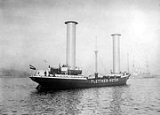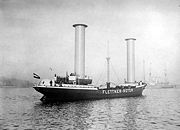
Flettner ship
Encyclopedia


Ship
Since the end of the age of sail a ship has been any large buoyant marine vessel. Ships are generally distinguished from boats based on size and cargo or passenger capacity. Ships are used on lakes, seas, and rivers for a variety of activities, such as the transport of people or goods, fishing,...
designed to use the Magnus effect
Magnus effect
The Magnus effect is the phenomenon whereby a spinning object flying in a fluid creates a whirlpool of fluid around itself, and experiences a force perpendicular to the line of motion...
for propulsion. To take advantage of this effect, it uses rotorsails which are powered by an engine. The Magnus effect is a force acting on a spinning body in a moving airstream, which acts perpendicularly to the direction of the airstream. German engineer Anton Flettner
Anton Flettner
Anton Flettner was a German aviation engineer and inventor. He made important contributions to airplane and helicopter design...
was the first to build a ship which attempted to tap this force for propulsion.
Invention
Flettner's spinning bodies were vertical cylinders; the basic idea was to use the Magnus effectMagnus effect
The Magnus effect is the phenomenon whereby a spinning object flying in a fluid creates a whirlpool of fluid around itself, and experiences a force perpendicular to the line of motion...
. The idea worked, but the propulsion force generated was less than the motor would have generated if it had been connected to a standard marine propeller
Propeller
A propeller is a type of fan that transmits power by converting rotational motion into thrust. A pressure difference is produced between the forward and rear surfaces of the airfoil-shaped blade, and a fluid is accelerated behind the blade. Propeller dynamics can be modeled by both Bernoulli's...
. These types of propulsion cylinders are now commonly called Flettner rotors.
His first idea was to produce the propulsion force by using a belt running round two cylinders. Later Flettner decided that the cylinders would be better rotated by individual motors. Flettner applied for a German patent for the rotor ship on 16 September 1922.
Assisted by Albert Betz
Albert Betz
Albert Betz was a German physicist and a pioneer of wind turbine technology.In 1910 he graduated as a naval engineer from Technische Hochschule Berlin...
, Jacob Ackeret and Ludwig Prandtl, Flettner constructed an experimental rotor vessel, and in October 1924 the Germaniawerft finished construction of a large two-rotor ship named Buckau. The vessel was a refitted schooner
Schooner
A schooner is a type of sailing vessel characterized by the use of fore-and-aft sails on two or more masts with the forward mast being no taller than the rear masts....
which carried two cylinders (or rotors) about 15 metres (49.2 ft) high, and 3 metres (9.8 ft) in diameter, driven by an electric propulsion system of 50 hp power.
Voyages
Following completion of its trials, the Buckau set out on her first voyage in February 1925, from Danzig to Scotland across the North SeaNorth Sea
In the southwest, beyond the Straits of Dover, the North Sea becomes the English Channel connecting to the Atlantic Ocean. In the east, it connects to the Baltic Sea via the Skagerrak and Kattegat, narrow straits that separate Denmark from Norway and Sweden respectively...
. The rotors did not give the slightest cause for concern in even the stormiest weather, and the rotor ship could tack
Tacking (sailing)
Tacking or coming about is a sailing maneuver by which a sailing vessel turns its bow through the wind so that the direction from which the wind blows changes from one side to the other...
(sail into the wind) at 20-30 degrees, while the vessel with its original sail rig could not tack closer than 45 degrees to the wind.
On 31 March 1926, the Buckau, now renamed Baden Baden after the German spa town
Baden-Baden
Baden-Baden is a spa town in Baden-Württemberg, Germany. It is located on the western foothills of the Black Forest, on the banks of the Oos River, in the region of Karlsruhe...
, sailed to New York via South America
South America
South America is a continent situated in the Western Hemisphere, mostly in the Southern Hemisphere, with a relatively small portion in the Northern Hemisphere. The continent is also considered a subcontinent of the Americas. It is bordered on the west by the Pacific Ocean and on the north and east...
, arriving in New York
New York
New York is a state in the Northeastern region of the United States. It is the nation's third most populous state. New York is bordered by New Jersey and Pennsylvania to the south, and by Connecticut, Massachusetts and Vermont to the east...
harbor on 9 May.
However, it was found that the rotor system was less efficient than conventional engines. Flettner turned his attention to other projects and the rotors were dismantled. Baden Baden was destroyed in a Caribbean
Caribbean
The Caribbean is a crescent-shaped group of islands more than 2,000 miles long separating the Gulf of Mexico and the Caribbean Sea, to the west and south, from the Atlantic Ocean, to the east and north...
storm in 1931.
Types
Several types of rotor ships can be distinguished, similar to sailing ships. Both rotor sail-assist (hybrid) ships exist, as well as rotor sail only ships. Wind Ship Development Corporation has also worked out two types of sail assist setups, for use with different ships sizes.Most rotor ships have a system with an electric engine which allows the stopping or initial starting of the rotor by the sailor. This allows the sailor to control the rotor's RPM and direction of spin.
Uses today
The University of FlensburgUniversity of Flensburg
The University of Flensburg is a university in the city of Flensburg, Germany. It was founded in 1994. The University of Flensburg is the northernmost university in Germany, but it is not a "full university"...
is developing the Flensburg catamaran or Uni-cat Flensburg, a rotor-driven catamaran.
The German wind-turbine manufacturer Enercon
Enercon
Enercon GmbH, based in Aurich, Germany, is the fourth-largest wind turbine manufacturer in the world and has been the market leader in Germany since the mid-nineties. Enercon has production facilities in Germany , Sweden, Brazil, India, Canada, Turkey and Portugal...
launched and christened its new rotor-ship E-Ship 1
E-Ship 1
The E-Ship 1 is a RoLo cargo ship that made its first voyage with cargo in August 2010. The ship is owned by the third-largest wind turbine manufacturer, Germany's Enercon GmbH. It will be used to transport wind turbine components. The E-Ship 1 is a Flettner ship: four large rotorsails that rise...
on the 2nd of August 2008. The ship will be used to transport turbines and other equipment to locations around the world. The maiden delivery of turbines for Castledockrell Windfarm arrived in Dublin Port on 11th Aug 2010.
In 2009 the Finland-based maritime engineering company Wärtsilä
Wärtsilä
Wärtsilä is a Finnish corporation which manufactures and services power sources and other equipment in the marine and energy markets. The core products of Wärtsilä include large combustion engines...
unveiled a concept for a cruiseferry
Cruiseferry
A cruiseferry is a ship that combines the features of a cruise ship with a Ro-Pax ferry. Many passengers travel with the ships for the cruise experience, staying only a few hours at the destination port or not leaving the ship at all, while others use the ships as means of...
that would utilise flettner rotors as means of reducing fuel consumption. This concept has been linked with the Finnish ferry operator Viking Line
Viking Line
Viking Line is a Finnish shipping company that operates a fleet of ferries and cruiseferries between Finland, the Åland Islands, Sweden and Estonia. Viking Line shares are quoted on the Helsinki Stock Exchange...
, who have stated they will make a decision on whether or not they'll order new ships during 2010.
Stephen H. Salter and John Latham recently proposed the building of 1,500 robotic rotor-ships to mitigate global warming
Mitigation of global warming
Climate change mitigation is action to decrease the intensity of radiative forcing in order to reduce the potential effects of global warming. Mitigation is distinguished from adaptation to global warming, which involves acting to tolerate the effects of global warming...
. The ships would spray seawater into the air to enhance cloud reflectivity
Cloud reflectivity enhancement
Cloud reflectivity enhancement is also known as 'marine cloud brightening' or 'cloud whitening' on low cloud. An opposite scheme exists to reduce the reflectivity of higher, colder cirrus clouds. It is a geoengineering technique that works by solar radiation management. By modifying the...
. A prototype rotor ship was tested on Discovery Project Earth. The rotors were made of carbon fibre and were attached to a retrofitted trimaran and successfully propelled the vessel stably through the water at a speed of six knots. The focus of the experiment was based on the ability for the boat to move emissions free for a specialized purpose leaving it unclear whether or not the efficiency of the rotors was on parity or superior to conventionally propelled vessels.
See also
- Flettner rotor bombletFlettner rotor bombletThe Flettner rotor bomblet was a U.S. biological sub-munition that was never mass-produced. Based on the vertical Flettner rotor which takes advantage of the Magnus effect, a force acting on a spinning body in a moving airstream, it was developed toward the end of the U.S...
- TurbosailTurbosail-Concept:In 1980, Jacques Cousteau dreamed of creating a ship with a modern engine that would be powered, at least in part, by the wind, a clean, free, renewable energy source...
— used to propel Jacques-Yves Cousteau's AlcyoneAlcyone (ship)The Alcyone is a ship operated by the Cousteau Society. It was created as an expedition ship and to test the operation of a new kind of marine propulsion system, the turbosail. The Alcyone is equipped with two of these unusual sails, which are used to augment its diesel engines... - WingsailWingsailA wingsail is a form of marine propulsion similar to conventional sails. However, a wingsail is a built-up structure with airfoil cross-section, like an airplane wing, which shape can provide a much better lift-to-drag ratio than conventional sails....
- Windmill shipWindmill shipA windmill ship, wind energy conversion system ship or wind energy harvester ship propels itself by use of a windmill to drive a propeller.They use wind power through a mechanical or electrical transmission to the propeller...

